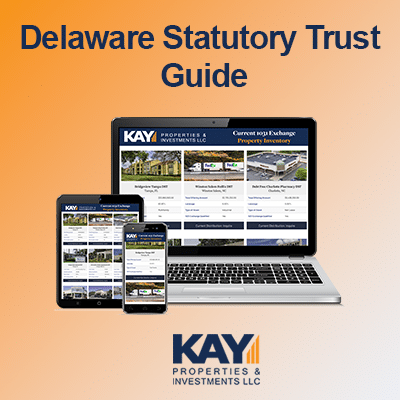
Key Highlights:
- What is a Delaware Statutory Trust?
- What is the history surrounding the Delaware Statutory Trust?
- What are the important dates that impacted the Delaware Statutory Trust?
- What are some of the benefits of the Delaware Statutory Trust?
- What are some of the risks of the Delaware Statutory Trust?
- What are some examples of Delaware Statutory Trust properties?
This article is designed to be a Delaware Statutory Trust guide for 1031 exchange investors, and provide a detailed look at the history surrounding Delaware Statutory Trust properties and why DST 1031 exchange properties are growing in popularity among real estate investors.
What is a Delaware Statutory Trust?
A good place to start a Delaware Statutory Trust Guide is with a definition of what is a Delaware Statutory Trust.
A Delaware Statutory Trust1, often referred to as a DST, is an effective and judicially secure legal entity that allows investors to participate in potentially higher-grade real estate investments they otherwise might not be able to afford via a 1031 exchange.
A DST sponsor company acquires and maintains various types of real estate and packages them as securities used to hold title to investment real estate. In today’s world, DST asset classes vary and qualify as a like-kind asset for 1031 exchanges.
History of the Delaware Statutory Trust
To understand the importance of the Delaware Statutory Trust for 1031 exchanges, this DST guide will now take a look at how trusts in general work and how this fits into the history of the Delaware Statutory Trust. Trusts have been used as a legal instrument to manage and protect assets for centuries. The concept of a trust was originally developed by the Romans, however the modern-day trust was created in England around the 12th century as a mechanism to hold property in a fiduciary relationship for the benefit of another person or group of people. The trust structure was used to protect land and assets from creditors or for religious and charitable purposes. In addition, trusts became popular as a way to pass on wealth to the next generation with the trust's trustees managing the assets for the benefit of the beneficiaries. Eventually the concept of trusts was adopted in the United States where they became a popular way to protect and manage assets. The first written trust in the United States was created by the Massachusetts Bay Colony in 1644.
The state of Delaware influenced more than the name of a DST, it actually influenced its entire composition. The concept of a business trust had been around for centuries, but in modernizing common law, Delaware was the first state to legally recognize statutory trusts when it passed the Delaware Statutory Trust Act in 1988. Since, statutory trusts are separate from their trustee(s), they are recognized as their own legal entity. However, it took nearly 75 years for a DST to evolve into its most current concept. Below is a short timeline of significant events.
Here’s the progression of events relevant to the history of DSTs and Delaware Statutory Trust laws2:
- In 1929 Delaware changed its laws concerning investments in corporations which were not previously included.
- 1931 saw the law changed again to permit investment in bonds in non-transport or public service corporations which were engaged in productive real estate, and which were secured by a first mortgage but free from any prior liens.
- The 1931 legislation inserted a net earnings requirement with respect to those corporations and added a 60% debt limit.
- In1933, perpetual trusts were linked to limited powers of appointment.
- A 1935 amendment added the ability of trusts to invest in: mortgage bonds when there had not been any loan default in the previous five years; land only within the estate of Delaware; and removed the “free from prior liens” stipulation.
- 110-year trusts were introduced in 1986, as was the “prudent investor” rule.
- 1995 saw perpetual trusts of personal property introduced.
- Domestic Asset Protection Trusts (APT) were introduced in 1997.
- 2006 saw Non Charitable Purpose Trusts introduced. These may, as of 2008, be made perpetual.
- DSTs were approved for 1031 Exchanges in 2004.
Listen more about the history of the Delaware Statutory Trust in this podcast featuring Kay Properties and Investments, Executive Vice President and Managing Director, Jason Salmon.
How Can a Delaware Statutory Trust Benefit Investors?
As part of this Delaware Statutory Trust Guide, it is important to explain how savvy real estate investors use Delaware Statutory Trust properties in their short, mid, and long-term real estate planning. While the Delaware Statutory Trust has both pros and cons, by deferring capital gains taxes, DSTs potentially help investors build and maintain wealth through real estate investment opportunities, including:
- Avoid the Three Ts: Delaware Statutory Trusts offer the opportunity for passive income streams, and therefore the opportunity to avoid active real estate positions and their (often unpleasant) demands, such as managing and maintaining tenants, toilets, and trash (i.e. Beneficiaries are exempt from landlord duties; allows passivity to investors; no management responsibility).
- Access to Long-Term NNN Properties: Depending on the property, triple net leased (NNN) properties offer investors a long-term income stream potential without the responsibility of daily management. Delaware Statutory Trusts offer investors access to these types of properties at much lower minimum investments as well.
- Non-Recourse Debt vs. Recourse Debt: An investor's liability to the lender is potentially limited through a Delaware Statutory Trust because most DST debt is non-recourse; a loan that adds an extra layer of safety and only seeks the property itself rather than the investor’s other assets in the event of a default. DSTs have varied amounts of leverage.
- Diversification* Into Smaller Amounts: With a DST, investors can potentially avoid concentrating risks on one DST property, and instead can distribute the risk to multiple assets. This means Investors have access to institutional-grade real estate for smaller dollar amounts.
*Diversification does not guarantee profits or protect against losses.
1031 Exchange with a Delaware Statutory Trust
Actual Examples of Delaware Statutory Trust 1031 Exchange Properties
Delaware Statutory Trust properties can qualify for a 1031 exchange, allowing investors to diversify their exchange proceeds across a variety of asset classes. To get an idea of what a typical Delaware Statutory Trust 1031 exchange property can look like, this Delaware Statutory Trust Guide will provide some actual examples of some typical DST 1031 properties. These examples are typical of the type of Delaware Statutory Trust investments Kay Properties & Investments tries to include in many of its DST 1031 portfolios.
Recently, Dwight Kay, Founder and CEO of Kay Properties and Investments discussed in detail the following three Delaware Statutory Trust offerings found on the firm’s Delaware Statutory Trust marketplace at www.kpi1031.com.
Delaware Statutory Trust Net Lease Distribution 55 DST, in Gunnison, CO
✔️Why Kay Properties considered essential businesses a potentially ideal investment for Delaware Statutory Trust real estate offerings?
✔️ Why Kay Properties likes FedEx Ground as a Delaware Statutory Trust tenant.
✔️ What makes the Net Lease Distribution 55 a potentially good asset for a Delaware Statutory Trust.
Pharmacy Net Lease 65 Delaware Statutory Trust in Encinitas, CA
✔️Walgreens recently signed a new 15-year absolute triple net lease, demonstrating a strong commitment to this Delaware Statutory Trust offering.
✔️ Pharmacy Net Lease 65 Delaware Statutory Trust is a debt-free DST with no risk of lender foreclosure.
✔️ Walgreens is an investment-grade tenant and an essential business.
✔️ Why this Delaware Statutory Trust is considered a trophy location.
Delaware Statutory Trust Net Lease Distribution 64 DST in Frankfort, NY
Key Takeaways from this investment presentation include:
✔️️ Hear more about this brand new 61,000-square-foot industrial Delaware Statutory Trust offering.
✔️ Why are industrial real estate assets so popular for Delaware Statutory Trust investors?
✔️ Why Kay Properties likes Pepsi as a tenant.
✔️ How this Delaware Statutory Trust Net Lease Distribution 64 DST offering has the potential for a 721 rollup as an exit strategy.
Kay Properties & Investments, LLC has years of experience and has helped hundreds of clients invest in DST real estate. When you’re ready to pursue a 1031 exchange into DST investment properties, speak with our trusted experts to learn how your family can potentially enjoy their benefits.
To get access to 1031 exchange Delaware Statutory Trust property listings, please visit the Kay Properties marketplace at www.kpi1031.com or by clicking on the photo below.
Sources for this article:
1Bell, R. (2023) “What is a Delaware Statutory Trust?”, Delawareinc.com
2Margraf, G. (1945) “Laws Relating to the Investment of Trust Funds, 1930-1937”, Duke Law Scholarship Repository.
